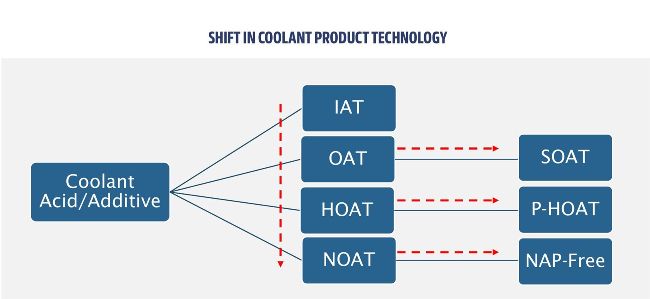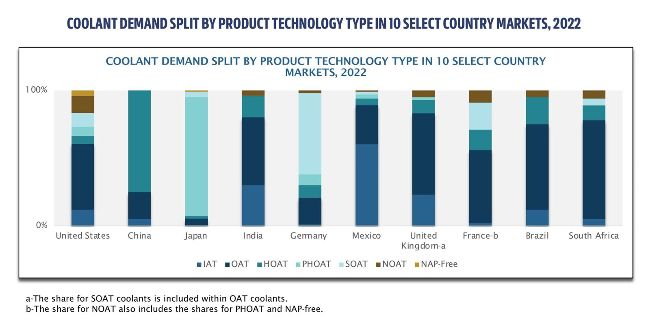FEATURE
How Automotive Cooling Fluids Are Stepping Up to Support Changes in the Automotive Industry
By Pooja Sharma, Project Manager, Kline Energy
FORMULATIONS
T
he automotive coolants market is experiencing changes, driven by shifts in automotive design technology, as well as the desire for longer fluid service life and better performance. Modern vehicles have engines that are downsized and have higher power density compared to conventional vehicles so that they are compact and can run faster. These engines function at higher temperatures and need to be supported by cooling fluids that can offer good heat removal and robust corrosion protection properties.
Automotive coolant technology is continuously evolving to accommodate new requirements set by the automotive industry. The industry is increasingly moving toward cooling fluids tweaked with additives and inhibitors that offer better corrosion protection and longer service life. Conventional green coolants, which are based on inorganic additive technology (IAT), are increasingly being phased out, while demand for organic and hybrid organic acid technology-based fluids is growing.
The transition in coolant technology is taking place unevenly in different geographies of the world, indicating the importance of the role played by economic standing, age of the vehicle parc, behavior of fluids end users, and maintenance practices followed in different country markets. For example, traditional IATbased coolants only have a sizable market in developing countries with older vehicle parc, such as Mexico and India. Fluids end users in these countries are typically price-sensitive and choose to use these fluids due to their lower price, which is well below the price of organic cooling fluids.
OAT and HOAT coolants are highly recommended for modern vehicles due to the many aluminium engine parts.
Newer cooling fluids formulated with organic acid technology (OAT) and hybrid organic acid technologies (HOAT) are now prevalent in most developed country markets, such as the United States and the United Kingdom. These types of fluids work better in modern vehicles that have more aluminium parts. In fact, leading automotive original equipment manufacturers (OEM) in the United States, such as General Motors and Ford, currently recommend OAT-based coolants for their existing vehicle models. The OAT-based extended-life coolants contain organic acids, such as sebacate and 2-ethyl hexanoic acid (2-EHA), and usually do not contain silicates or phosphates as in conventional IAT coolants. Extended-life OAT coolants typically have a recommended service life of 150,000 miles or five years (whichever comes first) in light-duty applications and up to three years or 500,000km (whichever comes first) in heavy-duty applications. These coolants provide long-term protection to aluminum and cast-iron parts.

NOAT refers to Nitrite Organic Acid Technology coolants formulation while NAP – Free refers to Nitrites, Amines and Phosphate free coolants formulation.
Asian OEMs are more inclined to use HOAT-based coolants that contain both organic acids as well as inorganic compounds but have lower concentrations of silicate compared to traditional IAT coolants.
HOAT coolants also have a life of 150,000 miles or five years (whichever comes first) in light-duty applications and up to three years or 500,000km (whichever comes first) in heavy-duty applications with the help of SCAs. Most of the leading coolant suppliers in China, such as China Petrochemical Corporation (Sinopec Group) and China National Petroleum Corporation (CNPC), are currently supplying HOAT-based coolant products.
PHOAT coolant formulation is similar to HOAT type of formulation, except for the additive component which is phosphate in place of silicate used in HOAT products.
In fact, going one step further are highly economically advanced country markets, such as Germany and Japan, that are pioneering the use of silicated OAT (Si-OAT) and phosphate HOAT (PHOAT) coolants. Si-OAT coolants, which are formulated with organic acid technology and further inhibited with silicate additives, are particularly recommended for high-pressure aluminum engines, where protection is of utmost importance. PHOAT coolant formulation is similar to HOAT type of formulation, except for the additive component which is phosphate in place of silicate used in HOAT products. Some examples of the leading German OEMs using Si-OAT formulations are Volkswagen, Mercedes-Benz, and Volvo; leading Japanese OEMs using PHOAT formulations are Honda, Toyota, and Subaru.
While highly advanced nations have almost entirely moved away from traditional IAT-based coolants toward new organic formulations, the shift to organic formulations is catching up slowly in developing nations. The penetration of SiOAT and PHOAT-based coolant remains low in developing countries due to the cost consciousness of consumers in these countries. Typically, advanced Si-OAT or PHOAT-based coolants are 1.5 to 2 times the price of IAT-based coolants, which renders these products cost-prohibitive amongst cost-conscious users.
Another important development in the automotive industry that is driving changes in coolant formulation is the proliferation of electric vehicles (EV). Nations around the world are embracing the era of e-mobility, and the electric vehicle market is experiencing explosive growth.
Modern vehicles have engines that are downsized and have higher power density compared to conventional vehicles. These engines function at higher temperatures and need to be supported by cooling fluids that can offer good heat removal and robust corrosion protection properties.
Thermal management systems in EVs are of supreme importance for ensuring extended driving range, improved battery life, and safety in these vehicles. Therefore, auto manufacturers are currently optimizing these vehicles with several designs for thermal management, such as air-cooling, in-direct liquid cooling, and direct liquid or immersion cooling.
Currently, the majority of EVs use indirect cooling technology, where the coolant does not come in direct contact with heated batteries. These coolants are used in a combination with water at a ratio of 50:50, as pure water offers good heat transfer properties. In smaller-sized EVs, such as Nissan LEAF and Wuling Mini EV as well as some Japanese EV models, the air cooling method still prevails, as this method offers cooling that is good enough to keep small-sized batteries of these cars under optimal temperature range.

The third technology is immersion cooling, where the EV battery unit is completely immersed in a dielectric cooling fluid, with electrical conductivity well below 10 micro siemens. This new technology is currently in the R&D phase and undergoing trials and has not yet been applied at scale by passenger car OEMs. However, the trend toward immersion cooling seems strongly driven by the developments in electric and fuel-cell vehicles. A compelling example of this is a July 2022 trial by TotalEnergies, in which the company incorporated an immersion-cooled battery in a road-going passenger car, a Volvo plug-in hybrid car.
It is also evident that in current times, nobody has a monopoly on innovation when it comes to immersion cooling technology. Several new players have entered this market to offer immersion cooling solutions for EVs. One prominent example of this is Xing Mobility, which is a Taiwan-based developer of immersion cooling battery packs. The company is an integrated solutions provider for EV batteries and offers modular battery pack systems based on immersion cooling technology. Xing Mobility recently partnered with Castrol to further develop its Immersion Modular Battery Pack technology solutions which will be targeted toward EV applications.
To sum it all up, in an era where mobility is defined by the quest for lower environmental impact, the changes in coolant technology have become the need of the hour. Environment protection norms are becoming increasingly stringent and are driving changes in vehicle designs, such as reducing the weight of the vehicles, smaller and higher power engines, changing vehicle metallurgical composition, increasing the number of electronic components, and growing penetration of electric vehicles. These changes in automotive design are exerting increased performance pressure on the vehicle’s thermal management system, and hence cooling fluids.
As automotive thermal management systems take the center stage as an enabler for increasing efficiency in automotives, cooling fluids are expected to experience significant changes.
As automotive thermal management systems take the center stage as an enabler for increasing efficiency in automotives, cooling fluids are expected to experience significant changes. The coolant industry is currently seeing developments in existing in-direct product technology which is targeted toward internal combustion engine (ICE) vehicles as well as current EVs, although it seems like a short-term solution for EVs. At the same time, the coolant industry is on the brink of a technological breakthrough for immersion cooling driven by strong trends toward electric and fuel-cell vehicle development. Keeping this in view, the next five to 10 years are anticipated to see landmark changes in coolant fluid technology transition and would certainly be an interesting market to observe.
The findings for this article have been drawn from Kline’s recently completed study on automotive coolants. The study covers, in detail, trends in this market and evaluates the demand for cooling fluids by ICE and electric vehicles in 10 country markets including Brazil, China, France, Germany, India, Japan, Mexico, South Africa, the United Kingdom, and the United States. .
This article was first published by Kline Group. To find out more, visit https://klinegroup.com/